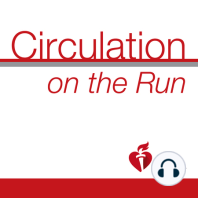20 min listen
Circulation August 17, 2021 Issue
ratings:
Length:
22 minutes
Released:
Aug 16, 2021
Format:
Podcast episode
Description
This week's episode features author Philippe Gabriel Steg and editorialist Gregg Stone as they discuss the article "International Observational Analysis of Evolution and Outcomes of Chronic Stable Angina: The Multinational Observational CLARIFY Study." TRANSCRIPT BELOW Dr. Carolyn Lam: Welcome to Circulation the Run, your weekly podcast summary and backstage pass to the journal and its editors. We're your co-hosts, I'm Dr. Carolyn Lam, associate editor from the National Heart Center and Duke National University of Singapore here with my other co-host, a little bird that you can hear I think in the background and then my real co-host, Greg. Dr. Greg Hundley: Thanks so much, Carolyn. Yes, I'm Dr. Greg Hundley. I'm not the bird this week. Associate editor, director of the Pauley Heart Center in Richmond, Virginia. Carolyn, so this week, our feature discussion is really going to be on the importance of stable angina and what that means prognostically. But before we get to that, how about we grab a cup of coffee, talk to our other bird friends and then we jump in and talk about the other papers in the issue. Would you like to go first? Dr. Carolyn Lam: Love it, Greg. Thank you so much. This first paper, very important question. We know that while the 99th percentile is the recommended diagnostic threshold for myocardial infarction, some guidelines also advocate the use of higher troponin thresholds to rule in myocardial infarction at presentation. It's still unclear whether the magnitude or change in troponin concentration can differentiate causes of myocardial injury and infarction in practice. And so today's paper is really important from Dr. Mills from the University Center for Cardiovascular Science Royal Infirmary of Edinburgh in the University of Edinburgh and colleagues. Dr. Carolyn Lam: What they did was a secondary analysis of the high stakes trial of more than 46,000 consecutive patients with suspected acute coronary syndrome. They evaluated the performance of the 99th percentile rule in threshold and thresholds of 64 ng/L and five times the upper reference limit for the diagnosis of type 1 myocardial infarction. They found that troponin concentrations at presentation have a low, positive predictive value for type 1 myocardial infarction and a threshold of 50 times the upper reference limit is required to achieve a positive predictive value of more than 70%. A change in troponin on serial testing only marginally improved positive predictive value for type 1 myocardial infarction over the presenting troponin alone. Dr. Greg Hundley: Interesting, Carolyn. Very important data. What's our take home message here. Dr. Carolyn Lam: Well, troponin concentrations at presentation are insufficient to distinguish type 1 myocardial infarction from other causes of myocardial injury or infarction and should not be used in isolation to guide management decisions in patients with suspected ACS. Consideration of other important clinical factors may be more helpful than any particular rule in threshold to guide initial triage and management. Dr. Greg Hundley: Wow, Carolyn, so really great new data and more data on the utility of these troponin concentrations. Dr. Greg Hundley: Well, my next paper comes from the world of preclinical science and it's from Professor Vladimir Kalinichenko from Cincinnati Children's Hospital Medical Center. Carolyn, as we know, pulmonary hypertension is a common complication in patients with alveolar capillary dysplasia with misalignment of pulmonary veins, a severe congenital disorder associated with mutations in the Foxf1 gene. Now, while the loss of alveolar microvasculature causes pulmonary hypertension in, and we're going to abbreviate this ACDMPV patients, it is unknown whether increasing neonatal lung angiogenesis could prevent pulmonary hypertension and right ventricular hypertrophy in these subjects. Dr. Carolyn Lam: Wow. Wow. Okay. Let's repeat that. ACDMPV stands for alveolar capillary dysplasia and m
Released:
Aug 16, 2021
Format:
Podcast episode
Titles in the series (100)
Circulation December 19/26, 2017 Issue: Circulation Weekly: Your Weekly Summary & Backstage Pass To The Journal by Circulation on the Run
